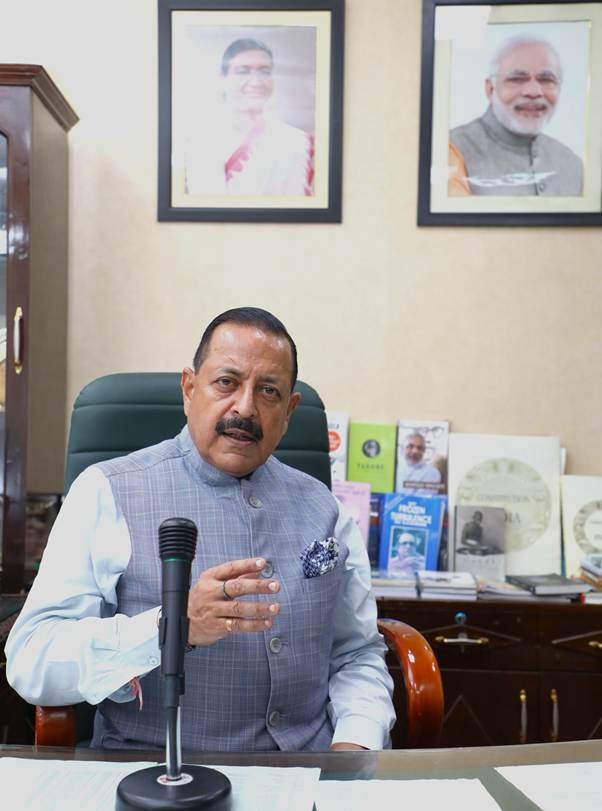30th July “NISAR” launch from Sriharikota will upscale ISRO’s international collaborations: Dr Jitendra Singh
30th July “NISAR” launch from Sriharikota will upscale ISRO’s international collaborations: Dr Jitendra Singh
NEW DELHI, July 27: Union Minister Dr Jitendra Singh said here today that the 30th July “NISAR” launch from Sriharikota will upscale ISRO’s international collaborations.
Briefing the media, the Minister for Science and Technology disclosed that the much-anticipated launch of the NASA-ISRO Synthetic Aperture Radar (NISAR) satellite mission is scheduled for July 30, 2025, at 17:40 hrs from the Satish Dhawan Space Centre, Sriharikota. As the first joint Earth observation mission between the Indian Space Research Organisation (ISRO) and the United States’ National Aeronautics and Space Administration (NASA), the event marks a defining moment in the journey of Indo-US space cooperation aa also in ISRO’s overall international collaborations, he said. The mission will be launched aboard India’s GSLV-F16 rocket.

Dr. Jitendra Singh, who has been monitoring the mission closely, said the launch reflects the maturing of strategic scientific partnerships and India’s emergence as a credible global player in advanced Earth observation systems. While expressing his wish to be physically present in Sriharikota to witness the historic event, the Minister acknowledged that the ongoing Parliament session may hold him back in Delhi.
“This mission is not just about a satellite launch—it is a moment that symbolises what two democracies committed to science and global welfare can achieve together. NISAR will not only serve India and the United States but will also provide critical data for countries around the world, especially in areas like disaster management, agriculture, and climate monitoring,” said Dr. Jitendra Singh.
Dr Jitendra Singh further noted that this mission lives up to Prime Minister Narendra Modi’s vision of India becoming a ‘Vishwa Bandhu’—a global partner that contributes to the collective good of humanity.
The NISAR mission combines the technological expertise of both agencies. NASA has contributed the L-Band Synthetic Aperture Radar (SAR), a high-rate telecommunication subsystem, GPS receivers, and a deployable 12-meter unfurlable antenna. ISRO, on its part, has provided the S-Band SAR payload, the spacecraft bus to accommodate both payloads, the GSLV-F16 launch vehicle, and all associated launch services. The satellite weighs 2,392 kg and will be placed in a sun-synchronous orbit, offering repeat imaging of the entire Earth’s land and ice surfaces every 12 days.
From an applications standpoint, Dr. Jitendra Singh highlighted that NISAR’s capabilities extend well beyond traditional Earth observation. “It will allow continuous monitoring of ecosystem disturbances and help assess natural hazards such as earthquakes, tsunamis, volcanic eruptions, and landslides. It will track even subtle changes in the Earth’s crust and surface movement. Importantly, the satellite’s data will also be used for sea ice classification, ship detection, shoreline monitoring, storm tracking, crop mapping, and changes in soil moisture—all of which are vital for governments, researchers, and disaster management agencies,” he said.
A key feature of the mission is that all data generated by NISAR will be made freely accessible within one to two days of observation, and in near real-time in case of emergencies. This democratization of data is expected to support global scientific research and decision-making, especially for developing countries that may not have access to similar capabilities.
Notably, the NISAR mission is the first time a GSLV rocket is being used to place a satellite in sun-synchronous polar orbit, signalling ISRO’s growing technical sophistication in supporting diverse space missions. The dual radar payload aboard NISAR will employ SweepSAR technology for high-resolution, all-weather, day-and-night imaging of the Earth’s surface with a wide swath of 242 kilometres.
Dr. Jitendra Singh also underlined the importance of Earth observation missions in the context of climate resilience and sustainable development. “Missions like NISAR are no longer confined to scientific curiosity—they are instrumental in planning, risk assessment, and policy intervention. As climate change impacts intensify, timely and accurate data from satellites like NISAR will be indispensable for governments to act proactively,” he said.
While the mission has seen a long gestation period of over a decade and a joint investment exceeding $1.5 billion, the payoff in terms of global utility and technological advancement is expected to be transformative. The launch of NISAR is being closely watched by space agencies, environmental researchers, and policymakers worldwide.
As the countdown to July 30 begins, Dr. Jitendra Singh reiterated that India’s space programme under the guidance of Prime Minister Modi is steadily transitioning from traditional utility-based missions to those that position the country as a knowledge contributor to the global commons. “NISAR is not just a satellite; it is India’s scientific handshake with the world,” he said.